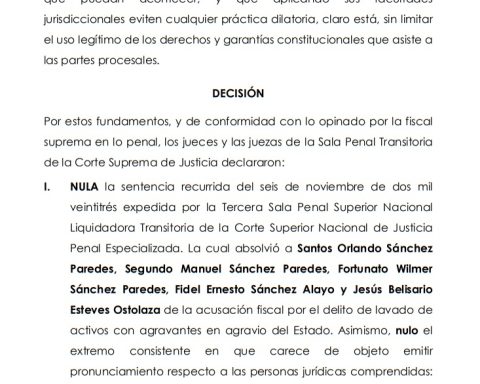Malkya Tudela / San Rafael
The grass is almost two meters high and bends docilely in front of the advance of the 4×4 vehicle. The grassy road leads to an area in the municipality of San Rafael where a company has opened huge gaps in the forest to delimit its property. That’s what the complaint says. From the ground, only a large dismantled opening can be seen in the forest. The drone shows a gap 25 meters wide and several kilometers in a straight line.
The area is a former forest concession within the Chiquitano Dry Forest now supposedly converted to agricultural land. In this place, 150 kilometers from the urban area of San Rafael, in the department of Santa Cruz, there are no plantations or cattle.
“We moved here because we received complaints from community members about massive clearing. This is happening not only on this side of the Chiquitania. We know that there is a tremendous agricultural expansion and laws that favor it,” says deputy María René Álvarez, fromCree. She led an inspection of the area on January 22.
Álvarez’s concern has to do with the annual recurrence of fires in the Chiquitano Dry Forest and the deforestation associated with this phenomenon. In 2019, 3.6 million hectares were burned in the Chiquitania and Chaco regions of the department of Santa Cruz, according to Fundación Tierra.
The forest fires affected less surface in the following years, but they have not stopped, and the situation worsens with the increase in temperatures and the drought of up to seven months in each administration.
The terrain is so vast that on the 150-kilometer route to one of the gaps there are no visible Chiquitano or peasant communities to ask for information. Just a group of people in temporary tents put stakes and operate machinery.
The complaint
To get to the place where you can see one of the gaps, you first travel along an established path, where foxes, iguanas, mountain mice occasionally cross… Other users of the road are motorcyclists traveling in the opposite direction, as if They came from San Matías heading for San Rafael. The guide seriously suggests that many are “mules” that transport drugs.
In a second moment, it deviates to enter minor routes, almost impassable and covered with vegetation, and with the guide of a connoisseur of the terrain.
The complaint is that the former Romano forestry concession has been delimited by an open gap in the forest, like a cordon, and surrounds about 45,000 hectares illegally, since all that area is public land.
“This parcel, which is 5,000 ha, was sold by the last owner of the Romano concession to I don’t know who, but he sells it to this Hacienda San Salvador-Empresa Agropecuaria Bellaluna. Those of this company made this demarcation of 45,000 ha,” says the complainant Carmelo Gomez, a community member of the area. It is presumed that the company has accumulated land by buying piecemeal from one or another occupant.
The Government has given settlement authorization to 28 intercultural communities within the same former forest concession, says the complaint, and this year the deadline for them to demonstrate their social function expires. It will be difficult for them to do so since they do not live in the area and the land could be reverted. There is also talk of white sticks and the sale of land at seven and 10 dollars per hectare.
Gómez also does not have property title or settlement authorization over the 500-hectare area that he claims and occupies in the former concession. While he talks with Deputy Álvarez and the press, her young wife records everything with her cell phone. He presumes that when the settlement of the intercultural communities is reversed, the company will keep the land.
His suspicion coincides with that of many people and authorities in Chiquitania: the interculturalists will end up selling to the big landowners.
By any means, the 2025 Patriotic Agenda that defines the Government’s development plans sees a scenario within three years in which “the forests are no longer considered idle land for agriculture” and in which “the process of distribution and redistribution of lands and territories”.
After eight hours of incursion, deputy Álvarez explains: “Unfortunately we have seen a lot of forest below, as we can say vulgarly, it is bare. We are going to prepare the requests for reports to both the ABT (Forest and Land Authority) and the INRA (National Institute of Agrarian Reform)”.
In addition to some deforested spaces -apparently with authorization-, it was possible to verify the immense gaps opened in the forest, as roads, which are not used for the circulation of vehicles because they are not maintained. It is not known where they go and it is assumed that surround some 45 thousand ha.
The clearing of a tall forest requires a large investment since it is impossible to do it by hand. Heavy machinery is needed, which on average costs 350 dollars per hectare worked.
In this area, “about 40 kilometers there is not a single soul, no one lives, there is no one who can say this land was mine 10 years ago,” says the complainant.
When leaving the area at night, near the city of San Rafael, the burning of long strings of recently felled vegetation draws attention. It has nothing to do with the supposedly illegal breaches in the forest, but it is an indication that other owners are clearing with machinery and burning during the rainy season.
San Rafael is a municipality that is part of the route of the old Jesuit missions, and has 21 Chiquitano indigenous communities affiliated with the Association of Indigenous Communities of San Rafael de Velasco (Acisarv). They have collective ownership of their land. On paper, the number of migrant peasant settlements exceeds that of native communities.
Acisarv also has an unanswered lawsuit pending to declare the Community Land of Origin (TCO) Esecatato in 173 thousand ha. At the time, the purpose of the indigenous center was to protect this area from the advance of forest concessions.
Target the intercultural
In his office in the urban area, the mayor of San Rafael, Humberto Vargas, confirms that the Romano, Caimán and Surutú forest concessions are now allocated for agricultural work. He calculates that in total there are about 150,000 hectares that have been set aside for that purpose. “Three forest concessions ceased to be, they returned to the State and the State is redistributing them as public lands for human settlements,” explains Mayor Vargas. He assures that he knows nothing about the distribution in favor of companies.
The Rafael mayor takes out a set of yellow folders, labeled with the names of communities, containing demands for services. Take a random file. It is the “Wasa Valle 7 de Febrero B” community that asks for a five kilometer road, a shortcut (to contain water), the clearing of two hectares per person and support with seeds.
The authority complains that this not only happens with the former forest concessions, but also with the municipal protected area of 69,143 ha, an important purple wood reserve.
“We do not know how many communities there are, to whom it has been given, that is, there is a total secrecy of the central government. The municipality should be the first to know to whom the land is being given because as municipalities we are going to have to provide health, education, roads, infrastructure, water. The money that we have budgeted (is based on) the previous census, that is, we are going to take our son out to give it to people who come from outside, ”he says.
In the folders of each community, photocopies of INRA reports are also attached, in which the names of the members of the community appear, in some cases with observations that they own land in another region of the country.
Another folder taken at random says “Comunidad La Providencia”. In the Official Gazette this property has Resolution 10243, of July 2013, of the Ministry of Rural Development and Lands.
This media managed an interview and request for information with the director of INRA in Santa Cruz but did not receive a response.
For now, in the municipality of San Rafael there are still two forestry concessions from the Cimal company and three ASLs (local social associations) with authorization to exploit wood. Mayor Vargas explains that 70% of the municipality has a forestry vocation.
The Chiquitano Dry Forest is a transition and connectivity zone for the region’s protected areas: to the north the Noel Kempff Mercado National Park, the San Ignacio municipal reserve, the Laguna Marfil Integrated Management Natural Area and to the southeast the National Park and Area Natural Integrated Management Otuquis and the Pantanal.
This report was prepared in collaboration between the newspaper Página Siete and the Environmental Information Network – RAI.

Photo: Page Seven
Fewer concessions, but more businesses in wood
The exploitation and export of wood increases despite the reduction of areas subject to forestry activity. In 11 months of 2021, the country’s export of wood and wood products registered 75.2 million dollars, a record figure if the 53.9 million and 48.6 million of 2020 and 2019, respectively, are considered.
Jorge Ávila, manager of the Forestry Chamber of Bolivia, confirms the reversal of forestry rights and explains that the forestry regime has had legal insecurity since 1996, when the INRA Law and Forestry Law 1700 were approved.
“It may be that a forestry right is reversed, but the soil does not change its suitability, the soil continues to be suitable for forestry and there should be respected the greater use capacity of the land,” says Ávila.
At the national level, the forest regime started in 1997 with 5.9 million ha with forest concession rights; currently that area has been reduced to two million hectares with special transitory authorization.
“Of 100% of the forest areas that we have lost in Santa Cruz, 80% are in the hands of intercultural communities, especially from Chiquitania, Guarayos and the Sara and Ichilo provinces,” says Ávila. “Nearly 20% are in the hands of large agricultural companies, especially in the Guarayos and Choré areas.”
Despite these circumstances, Jorge Ávila explains that in the last two years the logging activity has begun to improve because wood imports are regulated, export markets have recovered and around 80% of the wood produced comes from community operators. indigenous or peasants.
In this area, in 40 kilometers there is not a single soul, no one lives, there is no one who can say this land was mine ten years ago
Carmel Gomez, whistleblower
150,000
HECTARES
of three forest concessions
have been distributed for work
farm in San Rafael.
We have seen a lot of forest below that is ‘bare’. We are going to prepare the report requests to both the ABT and the INRA
Maria Rene Alvarezdeputy


















